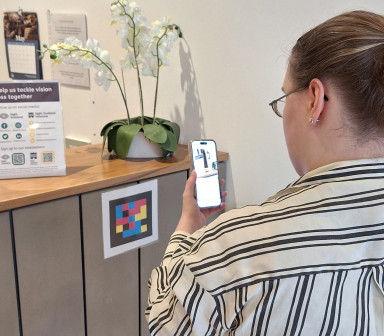Amy McAinsh, our Assistive Technology Intern, recently shared her thoughts on the NaviLens trial at the Hawkhead Centre.
Visually impaired people have trouble with traditional signs, making it hard to navigate new places on their own. NaviLens is a technology that helps improve navigation and accessibility. It uses special QR-like codes and a mobile app to provide information and directions. The NaviLens codes are easy to scan with a smartphone camera. The codes can be read from a distance and at wide angles making it easy for someone with vision impairment to detect and interact with the codes without needing to be right in front of them.
The trial, which took place over two days, involved groups of veterans, staff and volunteers trying out NaviLens in both morning and afternoon sessions. Amy reported that the feedback from the participants was overwhelmingly positive. The veterans found the app straightforward to use and particularly effective for those with little or no vision.
“We ran the trial like an activity at the centre,” Amy explained. “We deliberately didn’t tell anyone how to use it beforehand, and all our veterans, visually impaired staff, and volunteers who trialled it, agreed that it works really well. The veterans even started suggesting where the NaviLens codes could be placed. For example, they suggested placing a code beside the salad bar at lunch or outside in the garden.

“NaviLens is not intended to replace traditional mobility aids like long canes or guide dogs. Instead, it serves as an enhancement to make life easier for blind and partially sighted people."
“I had never used NaviLens before the trial, so I was unsure about it and how easy it would be to pick up the codes with my phone. But it was great, I had no problems at all, and my phone picked up the codes very quickly. We asked the veterans to imagine it was their first day at the centre and use NaviLens to try and navigate themselves around. Everyone who took part managed to use the app with very little help and all agreed it was something that could be very useful.
“NaviLens is not intended to replace traditional mobility aids like long canes or guide dogs. Instead, it serves as an enhancement to make life easier for blind and partially sighted people. It increases independence and is especially useful when visiting a place for the first time. It can also act as a reminder for people who may visit a place regularly but might forget where certain things are located.
“NaviLens' versatility makes it useful in so many ways. It can be used, for example, in schools, sports clubs, museums, transport, and outdoor spaces, ensuring that blind and partially sighted people can navigate different places more effectively. The system can also be adapted for hands-free use, such as through neck pouches or wearable devices, which is especially useful for those using a cane or guide dog.”
Amy adds: “With the veterans, we probably couldn’t have picked a more appropriate demographic for the trial, many of the veterans involved were older and also find technology harder to use. The positive feedback from them shows just how great NaviLens is.”
You may also be interested in
Leah Takes A Jump To Better Life With Sight Scotland
Leah Cameron, 22, who suffered vision impairment through an acquired brain injury, is getting ready to take a big jump forward to say thank you to the charity which has transformed her life.
Sight Scotland and Sight Scotland Veterans Appoint Paul Bott as New Chair of the Board
Sight Scotland and Sight Scotland Veterans are delighted to announce the appointment of Paul Bott as the new Chair of the Board.